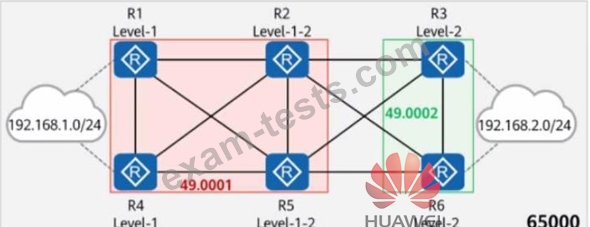Question 16
On the network shown in the figure, IS-IS runs on R1, R2, R4, and R5, and the area ID is 49.0001. IS-IS runs on R3 and R6, and the area ID is 49.0002. The import-route isis level-2 into level-1 command is configured on R2 and R5. In AS 65000, R1, R3, R4, and R6 each establish IBGP peer relationships with R2 and R5. R2 and R5 are RRs, and R1, R4, R3, and R6 are clients. The IBGP peer relationships are established using Loopback0. The IP address of Loopback0 on each router is 10.0.X.X/32, and the router ID is 10.0.X.X, where X is the number of the router. R1 and R4 import the external route 192.168.1.0/24 to BGP through the import-route command, and R3 and R6 import the external route 192.168.2.0/24 to BGP through the import-route command. Which of the following statements are true?


Question 17
MPLS is called multi-protocol label switching. Regarding the label description in MPLS, which of the following is correct? (Multiple choice)
Question 18
Which statements are wrong about OSPF Router LSA and Network LSA? (Multiple choice)
Question 19
On the OSPFv3 network shown in the figure, OSPFv3 is enabled on the interfaces connecting R1, R2, and R3. The router ID of each router is 10.0.X.X, where X is the number of the router.
If you check detailed information about an LSA on R3, the command output shows that R1 and R2 are DRs on the network.
Options:
If you check detailed information about an LSA on R3, the command output shows that R1 and R2 are DRs on the network.
Options:
Question 20
As shown in the figure, network administrator A on the R1 router, after modifying the MED value of the routing entry sent to R2 through the routing policy, can control the path of traffic entering AS100.



